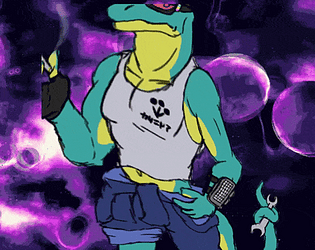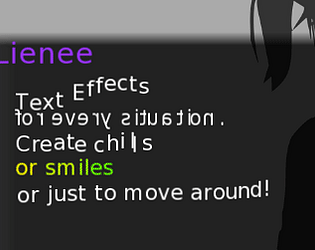I think you copied it from my script.rpy file which was just examples. You can remove the {=test_style} from inside the tag.
Wattson
Creator of
Recent community posts
You are free to modify it but yeah most of them don't put much of a delay on the effects. And the looping is just because they keep updating themselves as renpy calls them. I imagine you're looking to modify the SwapText though and you're free to modify that to how you want it to work. It uses it's swap_to_1 variable to keep track of which character it should be. So probably just need to treat the current timer variable it has to be a delay instead and remove the logic for switching back. Might need to add more code in there too if you want more than just the letter swap. Hopefully that helps though.
I've never had it flat out refuse to work. My best guess would be maybe your sprites are sharing names that are used to look up which to highlight. Having two sprites referring to the same one can often make it act screwy. Could be something else. but without more information about what's going on, that's my best guess.
Yeah, the kinetic text tags are a displayable being shown as part of an overall text displayable, but that text displayable doesn't know to pass it's style information down to the kinetic text tag's text. My solution to this was defining a style with all the properties you want, and then using the {=style} tag (https://www.renpy.org/doc/html/text.html#style-text-tags) INSIDE the kinetic text tag to carry that information in. While going through the text it's given, my text tags will try to keep track of other tags inside it and apply them to their text. So you'd want to do something like
style narr_text_style:
color "#fff"
outlines [(2, "#000000")]
size 1900
font "fonts/DisgustingBehavior-AZrA.ttf"
"{sc=10}{=narr_text_style}{outlines}No! You just don't want me to be happy!{/sc}"Not sure the style tag applies all of that attributes, especially outlines, or if that will necessarily work entirely. Though that's the general way I made it work.
While looking into this though I did learn that renpy now has some of this stuff built in. https://www.renpy.org/doc/html/textshaders.html So if it's not working it might be worth using their jitter instead.
Sorry, I can't say I tested it very extensively in NVL mode. I'll try to make a note to look into it more later. I have some guesses as to what the issue might be. I know Renpy likes to reset the whole textbox in ADV mode whenever it updates, so maybe it does something similar in NVL mode. If true, then the time being given to the displayables would be reset and not a lot I could do about that outside of awkwardly storing timers in globals in a way that'd be really messy. Though given your description, it that might not be the case and could be something else. I'll try to look into it when I have time but been busy lately.
I'll say I'm not entirely sure what you're asking, From the sounds of it, you're asking to have the shake and gradient tags moved to their own files. You are free to remove those sections are put them in their own .rpy file if you like, but I'm not sure how that will help you. If you're wondering how to use them, you just do "{sc}Some text{/sc}" for the scare tag, and the gradient tag is a bit harder, though I believe I provided some examples and reference for it in the comments of gradient_tags.rpy. Hopefully that helps but if you need more help feel free to ask!
No, I've never directly made an effect like that, but with my setup, it wouldn't be hard to make one if you know what you want and have some coding experience. Could maybe make one if you need though, but currently busy with another project so can't promise anything for a bit if you need it right now.
If I had to guess I would presume it's because when the scene starts, the character hasn't been speaking, so the speaking_char is probably either None or someone else. Then when the line starts, the character is then set as the speaking_char, so he lights up to normal. If you want them to start off already focused, you can manually set the speaking char by doing:
$ speaking_char = "guard1"
either before the transition or sometime during it. Which would then have the sprite start off in the talking state.
Hopefully that helps. But if it's some other issue, let me know and I'd be happy to help correct it.
Hi. Sorry for the late reply. I tried replicating the issue on my end, but doing the same setup (or at least what I can suppose from your comment) yielded results that looked correct to me. My best guess for the issue is that something about how you defined the sprites is causing renpy to reset the anim_time value, which would cause the sprite_highlight function to snap to the highlighted value. Which maybe you're confusing for the .2 seconds given .2 is pretty fast. Though I could be wrong. This is just my best guess given the information.
I tested with NVL and that didn't seem to make much of a difference. If you'd want to show me your code so I could test it and see what the issue might be, I'd be happy to take a look when I have time. (My username on discord is wattson if you need to reach out). But yeah I'm not entirely sure what the problem might be beyond my guess. Hope this was helpful and a solution to your issue can be found!
Hi. Sorry for taking a bit to get back to you. But yeah I appreciate you wanting to edit it to be easier for non-programmers to read it. I will admit I did my best when writing the original code to try and make it approachable as I could. If you have ideas on how to make it more approachable, I'd be happy to take feedback and upload a modified version on here with credit to you for the help. But if you're not making significant changes to the functionality and just adding comments, I feel like it'd be best to just have one project up. Sent a friend request on discord so we can chat more about it. Thanks for your feedback.
- Wattson
1. You'll probably need to add the glitch tag to the DispTextStyle class as part of the custom tags. That way it'll try and add it to every letter more or less.
2. Depends on what you want to do with the swap text. You'll probably want to update the SwapText class at least to take a list of texts to do. And then tell it to keep track of which one is being shown and increment it when you want it to go to the next one. But yeah the details from there are up to how you want to do it.
Sure I'll see what I can do about that. The main reason I split them up was originally to make it more modular. So if you didn't need every tag, you could pick and choose which you want, without it becoming a 1000+ line script file to go through. But given how many of my custom tags use the DispTextStyle class to handle other tags, probably makes sense to just lump them into one. So ppl just need to download one file even if they don't use all of them. I've just been pretty busy lately with my actual job and life stuff, so I'll see about when I get around to updating it. Probably when I have enough free time to work on another tool I've been meaning to release for a while.
The text's default position is going to be relative to where it would normally be placed on the screen. I don't know which specific tag is giving you problems, but I will guess it's the ATL tag. Depending on the values you give it, you may just be offsetting it too much and might want to bring them down closer to 0. Hard to know what exactly is the problem without more details, but hope you're able to get it fixed.
Sorry for the late response but I think I have an idea what's wrong. Thing is, Renpy won't even allow this to work even without the kinetic text tag. I tested it myself and the outline still wouldn't appear. I believe the problem is that for the style {=} tag, renpy will only apply certain properties of the specified style. And sadly, outlines is not one of them. https://www.renpy.org/doc/html/text.html#style-text-tags
That said, there is an outlinescolor text tag. https://www.renpy.org/doc/html/text.html#text-tag-outlinecolor But I believe this would require the text to already have an outline, which you'd probably have to specify in your say screen. Maybe make a transparent outline that you can then replace with outlinecolor? I haven't tested this but I believe the solution is beyond the scope of my text tags sadly. But hope you're able to get your thing working!
I already noted that as being a bug in the demo. I think it has something to do with a whole line being made up of displayable inserts instead of actual text and renpy not being able to figure out the proper width of things. My best solution right now is to just say to add the line breaks in manually for where you know they should be. You can use \n or the {para} tag used in the demo. I know it's annoying but been too busy with other things to really look into a serious fix to avoid it. Sorry about that.
Not sure if I'll update it to include that. But if you want, you can go into the kinetic-text-tags.rpy and go down to the ScareText class. Near the bottom of the render function, you'll see
renpy.redraw(self, 0)
Just change that 0 to something else like 0.2 or 0.5 or something and should slow it down.






 Oh! It would seem there is a ContrastMatrix that isn't mentioned in the matrixcolor documentation. So yeah, using ContrastMatrix should work I believe. Here's the source code to prove it exists.
Oh! It would seem there is a ContrastMatrix that isn't mentioned in the matrixcolor documentation. So yeah, using ContrastMatrix should work I believe. Here's the source code to prove it exists.